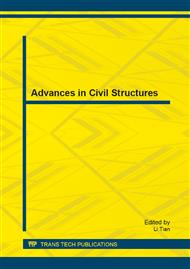p.1231
p.1236
p.1240
p.1244
p.1249
p.1253
p.1257
p.1264
p.1269
Thermal Gradient and Crack Monitoring of Concrete in Large Foundation during Construction
Abstract:
The embedded temperature and acoustic emission sensors were used for monitoring thermal gradient and crack development of the concrete in a large foundation. The results show that the vertical thermal gradient is obvious, while the transverse is relatively stable during 3 and 8 days, and when the peak temperature is reached at the third day after the concrete was cast, the crack development is most intense. Therefore, measures should be mainly taken to care the concrete, especially at the peak temperature.
Info:
Periodical:
Pages:
1249-1252
Citation:
Online since:
August 2013
Authors:
Keywords:
Price:
Сopyright:
© 2013 Trans Tech Publications Ltd. All Rights Reserved
Share:
Citation:


